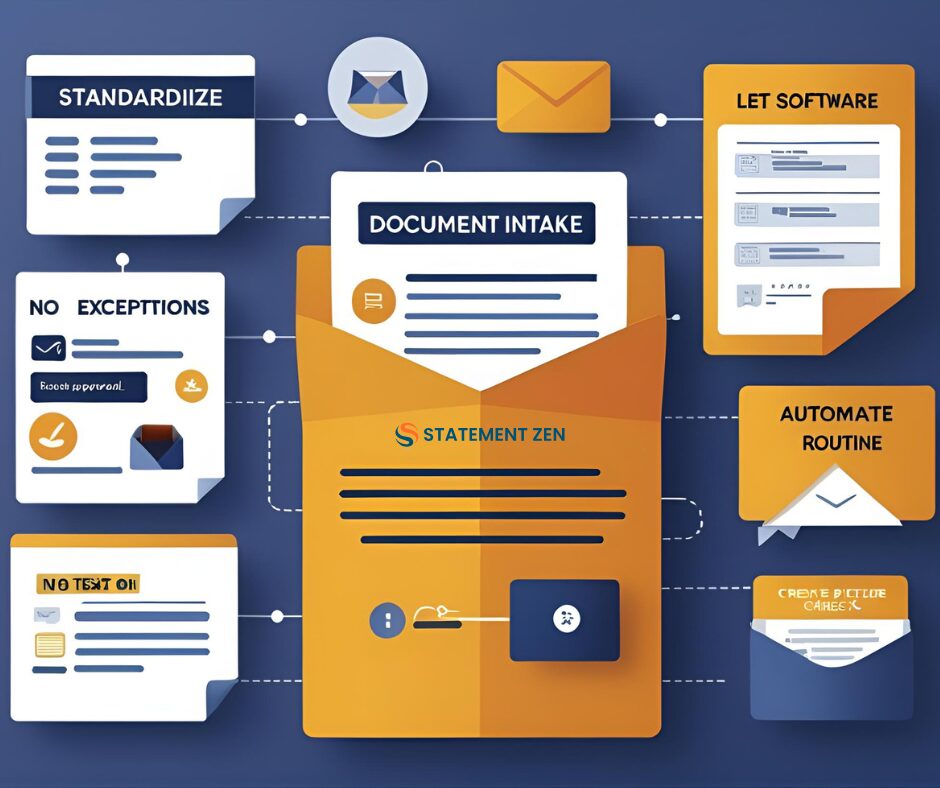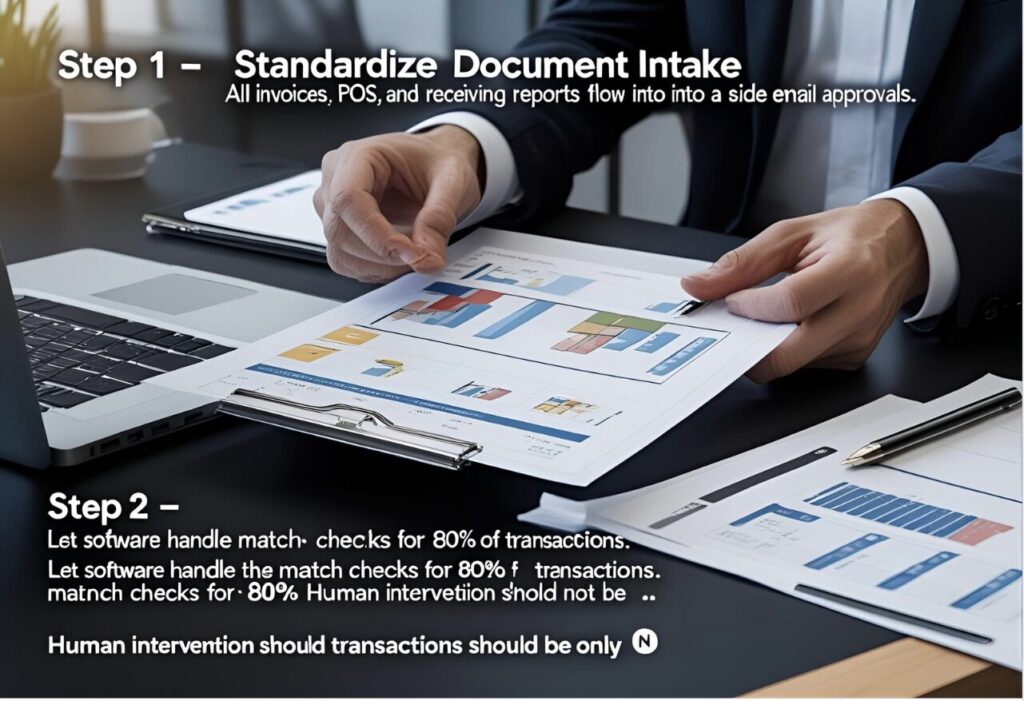In accounts payable, accuracy isn’t a “nice to have” — it’s the difference between protecting your margins and bleeding cash without knowing it. AP teams often get bogged down in chasing discrepancies, re-processing invoices, and fielding supplier disputes. The irony? Most of these problems can be prevented with one discipline done right: AP matching.
This guide breaks down the entire AP matching process, from invoice-level checks to supplier statement matching, so you can spot errors early, pay suppliers correctly, and close your books faster.

What Is AP Matching?
AP matching — short for accounts payable matching — is the process of verifying that the documents and data tied to a payment all agree before you approve it.
In practice, this can take several forms:
- 2-way matching: Comparing the purchase order (PO) to the supplier invoice
- 3-way matching: Comparing the PO, supplier invoice, and receiving report to confirm goods or services were delivered as ordered
- Statement matching: Comparing your AP ledger against the supplier’s statement to ensure every transaction is accounted for
The goal is simple: prevent overpayments, catch missing credits, and avoid disputes — all before money leaves your bank account.
To see how the process works in our system, check out our accounts payable matching overview.
Why AP Matching Matters
| Without Proper AP Matching | With a Well-Run AP Matching Process |
| Duplicate payments slip through unnoticed | Protects cash flow |
| Missing supplier credits worth thousands | Speeds up month-end close |
| Incorrect pricing or tax charges | Reduces manual rework and exception handling |
| Mismatches snowball into end-of-month delays | Strengthens supplier trust |
| Supplier disputes damage relationships and waste hours in admin time | Improves audit readiness |
| — | Real-time visibility into discrepancies with automated statement matching before they cost money |
And when automated statement matching is part of the workflow, you get real-time visibility into discrepancies — before they cost you money.
The 3 Levels of AP Matching
1. Invoice Matching
This is the frontline defense: checking that the invoice matches the purchase order (and receiving report in 3-way matching).
Key checks:
- Item descriptions and quantities match
- Unit prices align with the PO
- Tax and discounts are applied correctly
- PO and invoice reference numbers match
Even at this stage, automation can eliminate 80–90% of manual checking by flagging exceptions instead of having AP teams hunt for them.
2. Payment Matching
Once an invoice is approved, payment matching ensures that what you send to the supplier matches what’s recorded in your AP ledger.
Why it matters:
If a payment is processed incorrectly — the wrong amount, to the wrong vendor, or without the invoice being marked as paid — you risk both duplicate payments and misstatements in your books.
3. Supplier Statement Matching
This is where you check your AP ledger against the supplier’s statement. Unlike invoice matching, which happens before payment, supplier statement matching is about verifying that every transaction (invoices, credits, payments) is logged and aligned on both sides.
It catches:
- Invoices sent but never received
- Credits issued but not applied
- Payments recorded differently between your books and theirs
For many organizations, this is the final safety net before close. You can learn more about this in our automated statement matching resource.

AP Matching and the 3-Way Matching Method
3-way matching is widely regarded as the gold standard for AP controls, especially for goods-based businesses. It prevents paying for products not received or services not rendered.
Here’s the workflow:
- Purchase Order (PO) — issued when you place the order, specifying price, quantity, and terms.
- Receiving Report — confirms delivery of goods or completion of services.
- Supplier Invoice — must match both the PO and receiving report.
Only when all three match does payment proceed. This extra step adds security but can slow down AP teams without the right automation.
Building a High-Performance AP Matching Process
A great AP matching system is more than just checks and balances — it’s a workflow designed to be fast, accurate, and easy to audit.
Step 1 – Standardize Document Intake
All invoices, POs, and receiving reports should flow into a single system. No exceptions, no side email approvals.
Step 2 – Automate the Routine
Let software handle the match checks for 80% of transactions. Human intervention should only be needed for exceptions.
Step 3 – Apply Root Cause Analysis
Every mismatch should be investigated, not just corrected. Was it a supplier error, a data entry mistake, or a process gap? Fix the cause, not just the symptom.
Step 4 – Monitor Supplier Accuracy
Track error rates by vendor. This is your performance scorecard — and a powerful tool in supplier negotiations.
The Role of Automation in AP Matching
Manual AP matching can work for low volumes — but the second you’re processing hundreds or thousands of invoices and statements, it becomes slow, inconsistent, and risky.
Automation changes the game:
- Real-time matching: Flagging mismatches as soon as documents arrive
- Faster close cycles: Cutting days off month-end close by reducing exception backlogs
- Audit-ready records: Every match, every check, and every resolution logged for compliance
- Vendor scorecards: Automatically tracking supplier accuracy over time
Case Study: From 5-Day Close Delay to On-Time Every Month
A manufacturing firm with 450 active suppliers struggled with late closes because statement matching took nearly a week. Their AP team relied on manual spreadsheet checks, which left room for errors and missed credits.
After switching to automated AP matching with Statement Zen:
- Month-end close was reduced by 3.5 days
- Duplicate payments dropped by 82%
- Supplier credit recovery increased by $38,000 in the first year
- AP staff freed up 20+ hours a week for strategic work
Common AP Matching Mistakes and How to Avoid Them
- Treating balance matches as full verification — Matching totals isn’t enough; you need transaction-level checks.
- Not applying supplier credits promptly — This is free cash flow you’re leaving on the table.
- Letting exceptions pile up — The longer mismatches sit unresolved, the harder they are to fix.
- Skipping statement matching — Without it, you’ll miss invoices that never made it into your system.
FAQ: AP Matching
Q: What’s the difference between AP matching and statement reconciliation?
AP matching can include invoice, payment, and statement checks; reconciliation often focuses just on balances.
Q: Is 3-way matching always necessary?
Not for every purchase — but for high-value or high-risk suppliers, it’s essential.
Q: Can automation handle non-standard invoice formats?
Yes — modern systems use OCR and AI to match even scanned PDFs and supplier-specific layouts.
The Bottom Line
AP matching is the heartbeat of a healthy accounts payable function. When you master it — from invoice checks to supplier statement matching — you prevent cash leaks, keep suppliers happy, and give your finance team the accuracy they need for fast, confident closes.
Automation doesn’t just make AP matching faster — it makes it better, by catching issues humans miss and freeing up your team to focus on high-value work.
In AP, accuracy equals control. And control is how you protect your margins, speed up your close, and build supplier relationships that work for you — not against you.
